DHAMMAKĀYA MOVEMENT TIMELINE
1610: Wat Paknam Phasi Charoen (Wat Paknam) was founded by royal edict in what is now a district of metro Bangkok.
1600s-1800s: Much popular Buddhism in northern and northeastern Thailand (and adjacent areas) was versions from which the modern Dhammakāya movement developed, including the distinctive meditation method.
1916: Phra Mongkol Thepmuni (1884-1959) “rediscovered” the vijjā dhammakāya meditation system, the foundation of the modern Dhammakāya movement.
1916: Phra Mongkol Thepmuni was appointed abbot of Wat Paknam and set about building it into a major Buddhist center in Thailand.
1959: Phra Mongkol Thepmuni died.
1970: Khun Yay Ubasika Chandra Khonnokyoong (1909-2000), a prominent Mae chi of Wat Paknam, founded a Wat Paknam meditation center in Pathum Thani.
1979: The meditation center officially became a temple, Wat Phra Dhammakāya. Phra Dhammachayo became its first abbot. His assistant abbot was Phra Dattacheevo.
1991: Wat Luang Pho Sot Thammakayaram was founded.
1999: Phra Dhammachayo of Wat Phra Dhammakāya stepped down as abbot over corruption charges. Phra Dattacheevo became acting abbot.
2006: Phra Dhammachayo was reinstated, but stepped down in 2011, probably for health reasons. Phra Dattacheevo again became acting abbot.
2016-2017: Thailand’s military government tried several times to arrest Phra Dhammachayo on new corruption charges, but he disappeared. Phra Dattacheevo was also charged and forced out as abbot.
2017: Dhammakāya movement’s influence in the Thai saṅgha was severely curtailed when their candidate for Saṅgharaja (already acting head) was rejected, and many Dhammakāya monks were purged.
FOUNDER/GROUP HISTORY
The term “Dhammakāya movement” is somewhat ambiguous. While in one sense, it refers to a particular version of Buddhism, most commonly characterized by its distinctive meditation method, there are three major currents. Wat Phra Dhammakāya is probably the most widely recognized, even among most Thai. However, the movement’s founder, Phra Monkol Thepmuni, was Abbot of Wat Paknam Bhasi Charoen, which came first, and remains a separate current. Mae Chi Chandra Khonnokyoong, a meditation master who trained for many years at Wat Paknam, began the second current when she founded a meditation center in 1970 that would later become Wat Phra Dhammakāya. One of her star students, Phra Dhammachayo, became the first abbot and built it into the most prominent current temple. The third main current is Wat Luang Pho Sot Thammakayaram, which is from the same tradition. Thus, there are several “founders” of various temples, but all the temples recognize Phra Monkol Thepmuni as the master who started the modern movement.
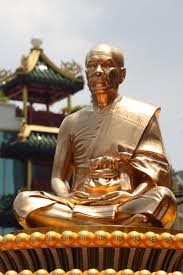
Phra Mongkol Thepmuni (his monastic name at the time of his death) [Image at right] was born in Suphanburi province in central Thailand in 1885. His family engaged in rice farming, and some biographical accounts stress his humble origins. Actually, the family was moderately prosperous by the standards of rural Thailand since they owned rice barges to engage in trading, and employed some workers. His father died when he was fourteen, and he ran the family business until twenty-two, when he was ordained (Dhammakaya Foundation 2010a; Cholvijarn 2019; Magness n.d.; Newell 2008).
As a monk, Phra Monkol Thepmuni was very determined to deeply understand Buddhism, and frustrated by the inability of most rural monks to teach much depth. He therefore embarked on extensive efforts toward mastering both meditation and Pāli scholarship. The meditation required residence in a number of temples scattered around Thailand to learn from recognized masters. Pāli scholarship necessarily included some time in the scholastic center in Bangkok. His background thus includes fairly extensive knowledge of the range of Buddhist thinking and practice in Thailand at the time. As the culmination of these efforts, Phra Mongkol Thepmuni “rediscovered” vijjā dhammakāya meditation in 1916 during an intensive session, and he started teaching the method.
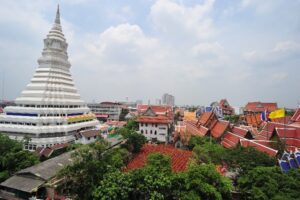
He was also appointed Abbot of Wat Paknam [Image at right] in 1916, although this was only indirectly related to his particular meditation achievement. Wat Paknam was a Royal temple which had existed for several centuries, but it had declined in size to only a few resident monks. Phra Monkol Thepmuni was already gaining some reputation for being outspoken and somewhat unorthodox for his non-official elements of esoteric Theravāda, but also for being very energetic and capable. Either characteristic is sometimes cited as the reason for assigning him to Wat Paknam. That is, either because the temple was obscure and he would be out of the way or because the temple needed to be revived and he would do the task well. Whatever the reason, he was quite successful at building it, and it became the base for spreading the vijjā dhammakāya meditation method, which he believed was an excellent way to make meditation more accessible to the larger population.
Phra Monkol Thepmuni also taught the dhamma, which was somewhat unusual. Most monks focused on either developing meditation skills or preaching the dhamma, but rarely both. Wat Paknam became a center for both meditation and dhamma learning. By the time of his death in 1959, it had become one of the leading temples in Thailand, with hundreds of monks in residence, a number of branch temples and meditation centers, a Pāli study institute, and one of the largest communities of mae chi (essentially nuns), who played a major role in helping propagate Wat Paknam’s teachings and meditation (Seeger 2006).
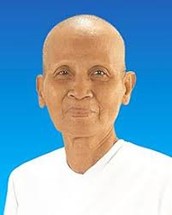
Khun Yay Maharatana Upasika Chandra Khonnokyoong (1909–2000), [Image at right] founder of the second current, was born into a rural family in Nakhon Pathom province in a district roughly fifty kilometers east of Bangkok. Perhaps similarly to Phra Monkol Thepmuni’s case, her family was more or less middle class by the standards of rural Thailand. Not surprisingly, however, she was illiterate as it was rare for rural women receive much education at the time. She started learning meditation in the late 1920s, moved to Bangkok near Wat Paknam in the mid-1930s, and began practicing at the Wat while working as a maid in a relative’s home. In 1937, she formally became a mae chi at the Wat. Eventually her meditation skills were sufficiently advanced that she was assigned to teach, and she built up a loyal following, notably including many university students (Cholvijarn 2019; Dhammakaya Foundation 2010b; Newell 2008).
Wat Phra Dhammakāya stresses Mae chi Chandra’s humble background, noting with pride that it proves her great achievements came from mastery of vijjā dhammakāya, rather than scholastic accomplishment. Her central role in founding and helping build Wat Phra Dhammakāya into a huge worldwide movement makes Mae chi Chandra “perhaps the most influential nun in Thai Buddhist history” (Scott 2010:503).
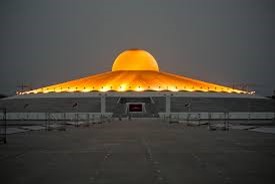
Mae chi Chandra founded a meditation center in Pathum Thani (just north of Bangkok) for Wat Paknam in 1970, which later became Wat Phra Dhammakāya. [Image at right] Two of her leading students, who had been among her following at Wat Paknam, were instrumental in building the temple. Chaiyabun Suddhipol, born in 1944 in Singburi, central Thailand, studied marketing at Kasetsart University, and ordained upon graduating in 1969. He helped found the meditation center, and as Phra Dhammachayo became its first abbot. Phadet Phongsawat was also a student at Kasetsart studying agriculture, ordained in 1971, and as Phra Dattacheevo became assistant abbot. These two ran Wat Phra Dhammakāya more or less continuously from its founding. Phra Dhammachayo has largely been the charismatic strategic leader, and Phra Dattacheevo proved to be a very efficient administrator (Dhammakaya Foundation 2010b; Mackenzie 2007; Newell 2008; Scott 2009).
Satha-Anand notes that Wat Phra Dhammakāya followers “seem to represent a segment of the emerging middle class that is keen on achieving both worldly pleasure and peace of mind in religious form“ (1990:407). Phra Dhammachayo was quite skillful at further adapting the temple toward these prominent middle-class views. “His modern view of Buddhist life extended to religious practice, in that he has always focused on the practical benefits of meditation within contemporary life – helping to improve grades, facilitating harmony within families, overcoming addiction, and securing desirable employment” (Scott 2009:77).
More mundane details also appealed to the growing middle class. Phra Monkol Thepmuni had started some of this innovation, for example, by cleaning up Wat Paknam and refurbishing some of the buildings. He also had a temple kitchen built so monks could spend more time building meditation skills rather than on alms rounds. Wat Phra Dhammakaya furthered this trend. “The traditional Thai temples do not meet the expectations of Wat Phra Dhammakaya members in areas such as cleanliness of the temple and its grounds and education of the monks. Wat Phra Dhammakaya offers a modern, efficiently administered system, with dynamic leaders” (Mackenzie 2007:191). Phra Dattacheevo was instrumental in making sure temple administration could deliver this middle-class ethos (Dhammakaya Foundation 2010a; Mackenzie 2007; Newell 2008; Scott 2009).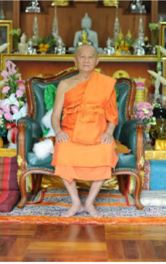
In 1991, Phra Thepyan Mongkhon (1929‒2018) [Image at right] became the first abbot of the new Wat Luang Pho Sot Thammakayaram, the third current. He was born into a Thai-Chinese trading family in Buriran, northeast Thailand, and was well educated (BBA and MPA) with a successful career before ordaining at Wat Paknam at age fifty-seven. The temple was established from a successful meditation center he had helped start for Wat Paknam in central Thailand nearly a decade earlier. There are conflicting accounts about whether he and some of the Wat Paknam monks had fallen out with Wat Phra Dhammakāya over exactly what the correct teaching of vijjā dhammakāya should be. Later, Phra Thepyan Mongkhon clearly did criticize Wat Phra Dhammakāya for deviating from proper meditation teaching, as well as for excessive commercialization, and somewhat distanced his temple from it (Cholvijarn 2019; Mackenzie 2007; Newell 2008).
Most informed observers view Thailand’s modern Dhammakāya movement as a revival of traditional popular currents of Theravāda that have been present for centuries, especially in northern and northeastern Thailand and adjacent areas. (Some forms are often called yogāvacara, e.g., Crosby 2000.) The “orthodox” modern version of Thai Theravāda was largely constructed through reforms carried out in the nineteenth and early twentieth centuries. These reforms aimed to eliminate “superstition” and to “rationalize” Buddhism as part of the broader effort to modernize and strengthen the Thai State under pressure from Western colonialism (Keyes 1971; Tambiah 1976).
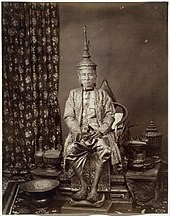
The Thammayut order was the main instrument for the State project to return to the Buddha’s original teachings and purify Buddhism of superstition, mythology, and other “non-Buddhist” elements. One of two official orders in Thai Theravāda today, it was founded by King Mongkut [Image at right] during his time as a monk (1824-1851) before ascending the throne. Crosby (2014) notes that the French pursued similar policies in Cambodia to strengthen the colonial state. Largely, however, other versions of Theravāda were absorbed, or simply downplayed, rather than thoroughly suppressed (Cohen 2001; Puntarigvivat 2013). Thus, much popular practice in these versions never really completely disappeared.
Long-term enforcement of State policy has resulted in a somewhat stagnant official Buddhism in modern times. “Monks not sympathetic to state policies are structurally excluded from senior administrative positions within the Sangha, just as monks supportive of the regime in power receive material and career advancement in the Sangha hierarchy” (Puntarigvivat 2013, p. 11). Nowadays, many middle class Thai feel that leadership in the modern saṅgha (community of ordained monks) has lost touch with the modern world (e.g., Taylor 1999; Mackenzie 2007; Puntarigvivat 2013). “The clergy’s dependency on state support has made it weak and out of touch with public sentiments and needs. That’s how it has become socially irrelevant” (Ekachai 2018). Phra Payutto, a leading scholar-monk of the “reform-from-within” current, summarized the problem well:
when the modernists began to be disillusioned and dissatisfied with modernization [they] turned to find meaning and answers from [Buddhist] tradition. However, as the traditionalists have long been far removed from the real world of changing values, they cannot supply the answers or satisfy the need of the modernists (Payutto 2007:56).
Modern urban middle class Buddhist reform is the public re-emergence of diversity in recent decades (summarized, e.g., in Speece 2013, 2019). “This religious diversity [is] taking place in parallel with the growth of lay Buddhism. The lay Buddhists [are] playing greater roles in religion and we eventually see the emergence of new Buddhism with lay people as core leaders instead of monks” (Visalo 2012). The Dhammakāya movement is one manifestation of the trend. It builds on Buddhist traditions long established in Thailand, but the strong orientation toward the lay middle class has fostered considerable adaptation to modern lifestyles.
Rawlinson (2000) proposed a categorization of Buddhist religious experience that is helpful in understanding versions of Thai modern reform Buddhism and that we employ here. He uses two key dimensions. “Hot-cool” distinguishes self-realization vs. other-directed / granted salvation. Structured-unstructured distinguishes order and a well-defined path toward salvation vs. lack of distinction between path and goal. So, for example, salvation in official Theravāda is essentially a matter of self-realization (cool), following a well-defined (structured) path laid out by the Buddha and various masters over the centuries. Vajrayāna gives a prominent role to the masters and to various gods, buddhas, and bodhisattvas (hot) who must provide guidance on how to follow the (structured) path. In Zen, there is no obvious path (unstructured); salvation is attained through (often sudden) self-realization (cool). Pure Land is a faith-based version, with no path (unstructured), where salvation is granted to the devoted by the grace of a Buddha or bodhisattva (hot).
Official institutional Theravāda in Thailand is “cool-structured” in this taxonomy (Speece 2013). Of course, cool-structured variations had been present for centuries, especially among the more scholarly-oriented members of the saṅgha, but the issue took on some urgency during the colonial period in Southeast Asia. “One of the objectives of erecting a national sangha organization with its center in Bangkok was the elimination of regional variants considered dangerous to orthodoxy in the interest of a national standardization and homogenization” (Tambiah 1976:239). Schlamm (2001:26) considers it “a defining feature of these [cool] traditions to separate themselves from the mythology of their surrounding cultures.” Many Theravāda countries engaged in “reassessing their traditional religious identity” and “strengthening the foundation of their monastic institutions” to deal with the pressures of colonialism and modernization (Cantwell and Kawanami 2002:57).
As already noted, however, other versions never really disappeared. They could not disappear, because controlling the administrative hierarchy and official doctrine of the State saṅgha had little impact on various psychologies among the population. In marketing language, Rawlinson’s (2000) four quadrants represent a framework for psychographic segmentation (Speece and Roenjun 2016), and versions of Buddhism in each quadrant have developed to appeal to different psychologies. The Dhammakāya movement is a hot structured form (Speece 2013), and it exhibits many characteristics similar to Vajrayāna. However, the occasional modern criticism that it is Vajrayāna, rather than Theravāda, ignores substantial evidence that Dhammakāya is simply a modern adaptation of traditional Theravāda forms. Certainly, it is not the official State Buddhism, but esoteric / tantric versions of Theravāda have been present in Southeast Asia for centuries (e.g., Cholvijarn 2019; Crosby 2000; Foxeus 2013, 2016; Newell 2008).
Wat Paknam helped bring this version back to the mainstream. It may be more or less accurate that Phra Monkol Thepmuni “rediscovered” vijjā dhammakāya meditation, which supposedly had been lost for centuries. But largely, elements of the method had never been entirely lost, even if official doctrine aimed to submerge “non-rational” forms of meditation. It seems likely that his wide knowledge of practice gained during his determined efforts to better understand Buddhism played a role. The meditation skills and doctrinal knowledge he developed eventually allowed him to recognize how the elements all fit into a coherent whole, vijjā dhammakāya (Choljivarn 2019; Newell 2008). He seems also to have anticipated the need for Thai Buddhism to begin adapting to the modern world, somewhat before the rise of modern lay-oriented middle class reform movements made this so obvious.
Most versions of reform Buddhism in Thailand appeal to the middle class because they adapt to modern middle class needs (e.g., Speece 2013, 2019). Three essential spiritual elements are ethics, meditation, and the possibility of nibbāna achievable in this lifetime, rather than after eons of rebirth. “The religious crisis in the modern nation state in Thailand and Burma centres on the relevance of lay ethics in increasingly diversified social, political and religious contexts” (Schober 1995:317). Meditation among lay practitioners has likewise played a key role in the revival of Buddhism throughout the Theravāda countries of Asia (Swearer 2010). Buddhadāsa, a prominent cool-structured “reform-from-within” monk, is perhaps the most well-known proponent of nibbāna in the here-and-now (Buddhadāsa 2016), but most Thai reform Buddhism agrees that it is achievable this lifetime. Like Buddhadāsa, “Thammakāi emphasizes that Nibbāna is to be sought within the world, not through withdrawal from the world” (Keyes 1992:336).
Finally, a sometimes overlooked aspect is the role of women; most of the modern middle class favors more equality for women (e.g., Buranajaroenkij et al. 2018). “In the past two decades, women have been playing more roles in Thai Buddhism, not only as the supporters of monks but also as an important force in Lay Buddhism. Their roles in the realms of academics and practices have helped Thai Buddhism to be relevant to the way of life of people in modern society” (Visalo 2012). Lay people have become annoyed with the saṅgha hierarchy’s resistance to equal treatment for women.
The clergy see it as a technical problem. Others see it as sheer misogyny. … If the current draft charter cannot protect female monks, then the people can. Disillusioned with monks’ widespread misconduct, people are increasingly seeking spiritual teachers outside the male-dominated clergy. It is now no longer necessary for spiritual teachers to be monastics (Ekachai 2016b).
From his start at Wat Paknam, Phra Monkol Thepmuni began changing traditional temple life and interaction with the lay population in ways that anticipated modern middle class concerns. He clamped down on lax monastic discipline (e.g., Magness n.d.; Scott 2009), which has worried lay people for decades. (“The only way for the clergy to restore public faith is by being true to the Vinaya, the monastic code of conduct. That, and only that”) Bangkok Post 2008). Meditation training for lay people was expanded, as well as dhamma talks, both with participation from advanced mae chi as teachers (Choljivarn 2019; Magness n.d.). Many of these aspects were not really innovations as much as revivals of the traditional Theravāda driven underground. “Expertise in the yogāvacara tradition is not restricted to monks. Lay people, including women, may be practitioners, and may even be teachers to monks” (Crosby 2000:142).
On the role of women, as with many issues, Wat Paknam generally avoids direct challenge to official saṅgha positions. Wat Paknam’s position seems to be roughly that there is no doctrinal issue preventing ordination of women, but that saṅgha administration has the authority to set the rules (Wat Paknam 2016). (This contrasts with the Thai bhikkunī movement, which quite aggressively challenges the patriarchal norms of official Theravāda) (e.g., Tomalin 2006). Meanwhile, the mae chi status has risen, and Wat Paknam mae chi operate fairly extensively, but somewhat under the radar because they do not claim to be bhikkunī. Nowadays, “[mae chi] interaction with the lay people has often come to resemble the relationship between the monks and the laity” (Seeger 2009a:806).
DOCTRINES/BELIEFS
Hot-structured Dhammakāya shares much of the same doctrine as official cool-structured Thai Theravāda. (Rawlinson 2000 notes that adjacent quadrants in his framework may overlap in many elements.) The differences, however, clearly indicate this is not official cool-structured Theravāda. In hot-structured forms, “the cosmos is vast and inhabited by innumerable powerful beings; liberation consists in finding one’s way through the labyrinth with the appropriate passwords” (Rawlinson 2000:100). The teacher in hot-structured traditions can be characterized as “magician / knows the secret” (Rawlinson 2000:103), and “the teaching is never given all at once, but only when necessary and then only in cryptic form” (Rawlinson 2000:106). In Buddhism, such esoteric fo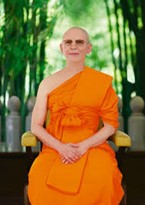 rms are usually associated with Vajrayāna, which Rawlinson uses as an example for this quadrant.
rms are usually associated with Vajrayāna, which Rawlinson uses as an example for this quadrant.
A nineteen-year veteran Wat Phra Dhammakāya monk, who achieved a very high level in the hierarchy before leaving the movement, offers an inside view. Wat Phra Dhammakāya’s mythology maintains that ‘the universe is the battlefield between the Dhammakāyas of the Light and Darkness’ (Laohavanich 2012:495). The Abbot, Phra Dhammachayo, [Image at right] is rumored to have great psychic and meditative powers, and he leads the forces of light (e.g., Mackenzie 2007). Wat Phra Dhammakāya followers participate, primarily through intense mass meditation, and final victory over the forces of darkness will lead to collective enlightenment (Taylor 2008; Laohavanich 2012).
unlike other Buddhist communities in Thailand where the teachings of the master remain open to the public, Wat Phra Dhammakāya is built upon rings of esoteric teachings .… When the newcomer has gained sufficient faith in the leadership of the wat, s/he will be introduced to a higher level of the teaching of Vijjā Dhammakāya where the conventional knowledge of Buddhism becomes almost insignificant (Laohavanich 2012:487-88).
Cool-structured Theravāda, of course, discounts such mythology, and also maintains that it is a vinaya offense to claim psychic powers to lay people (e.g., Seeger 2009b). However, this cosmic struggle between good and evil is not a Wat Phra Dhammakāya innovation, but can be seen in other esoteric Theravāda contexts. Foxeus (2012:244), for example, describes the “cosmic, Manichean contest between good and evil” in a Burmese version, and also notes similar cosmologies in Sri Lanka. Such mythology has occasionally been present in Theravāda millenarianism, non-official Buddhist nationalism’s frequent response to pressure from colonialism and modernization (e.g., Foxeus 2012, 2016; Mackenzie 2008). Millenarian movements resisting centralization by the Siamese state / saṅgha in modern times sometimes gave rise to holy men who used their advanced powers to protect Buddhism and the Buddhist community (e.g., Cohen 2001; Scott 2009).
Official Theravāda also accuses Wat Phra Dhammakāya of distorted views on nibbāna and anattā (non-Self). The conventional self is conditioned, i.e., it arises from the interaction of the five mental and physical aggregates (khandha), which themselves are conditioned and impermanent. In other words, self has no inherent existence, and realizing nibbāna is about letting go of all attachment to the conditioned and impermanent. The exact nature of nibbāna is incomprehensible to the unenlightened. The Buddha did not want to be drawn into fruitless discussion about such issues, which would distract people from progress on the Path and be a hindrance to enlightenment (e.g., Harvey 2013).
Wat Phra Dhammakāya teaches that nibbāna is attainment of the “True Self,” contradicting cool-structured Theravāda’s non-Self teachings. These Wat Phra Dhammakāya teachings are not entirely their own innovation either, but rather, build on historical forms of esoteric Theravāda. Wat Paknam and Wat Luang Phor Sodh Dhammakayaram both have similar teachings (Cholvijarn 2011, 2019), although they have managed to stay somewhat under the radar in the modern debate. Proponents of Dhammakāya beliefs more or less view non-Self teachings as skillful means; by teaching people to let go of (conventional) self, which is hopelessly entangled with the khandha and defilements, one can discover the pure True-Self.
Differing interpretations of nibbāna and anattā / attā have been key issues in various Buddhist traditions for millennia. In Mahāyāna, the dharmakāya is the eternal purified “body of the Buddha,” and (in some Mahāyāna) the tathāgata-garbha is this inherent Buddha nature still covered with defilements in the unenlightened (Williams 2008:106). Williams (2008:125 ff) characterizes Wat Phra Dhammakāya’s True-Self as a version of tathāgata-garbha thought in Mahāyāna. He notes, however, that most Thai proponents do not consider it Mahāyāna, but rather, “back-to-the-original” interpretations of the Buddha’s teachings. Cholvijarn (2019) sees parallel development of the concept in esoteric Theravāda, not direct borrowing. Some version of ideas about “bodies of the Buddha” have been present in Theravāda all along (e.g. Reynolds 1977). Certainly, historical textual material from Southeast Asian Yogāvacara traditions contain extensive reference to the Pāli Canon (e.g., Cousins 1997; Crosby 2000), but do not show much Mahāyāna influence.
Until recently, when Wat Phra Dhammakāya began to alienate many middle class and some factions of the elite by involvement in politics, these doctrinal disputes were not very prominent. Historically, orthopraxy has usually been far more important throughout Buddhism than strict orthodoxy. It is difficult to formally censure a monk who develops a reputation for advanced meditation skills and acquires strong moral authority by adhering scrupulously to the vinaya. Jackson (2003), for example, discusses how Buddhadāsa (cool-structured “reform-from-within”) was able to use this to introduce substantial doctrinal innovation. Zehner (1990) speculates that Phra Dhammachayo (and by extension, Phra Monkol Thepmuni earlier) could probably sidestep questions about doctrinal issues by presenting himself as a meditation master using the scriptures to guide practice.
Indeed, even if not predominant, versions of the dhammakāya doctrine have been widespread for quite a while among saṅgha, even at the top levels. For example, the Saṅgharāja (head of the official saṅgha hierarchy) argued in 1939 that nibbāna is True-Self. At that time, Buddhadāsa led the debate arguing the non-Self view (Williams 2008:125 ff; cf. Cholvijarn 2011, 2019). The controversy was not particularly acrimonious, and subsided for some time, but resurfaced once Wat Phra Dhammakāya became prominent. Phra Payutto has led continued vigorous defense of the orthodox non-Self doctrine (e.g., Cholvijarn 2011; Seeger 2009b).
RITUALS/PRACTICES
In esoteric traditions, there is no need to get into details of such complex doctrinal issues until followers are sufficiently advanced to follow them. It is certainly acceptable to focus on personal practice, which what most middle-class followers want. Most do not worry very much about doctrinal theory. In a sense, the middle class wants to recover traditional values, but do not regard simply returning to the past as a viable solution for the modern world. All three Dhammakāya currents understand this to some extent, but Wat Phra Dhammakāya has been the most skillful at addressing masses of people.
Their teaching would increasingly emphasize a lay piety and ethics framed in terms relevant to middle-class lifestyles. Claiming to be carrying out the vision passed on by Luang Phau Sot, they nevertheless purified that vision in accordance to the emerging middle-class religious values of their day … Thus, claiming to be heirs of the master, they subtly adapted his teaching and his vision to a new purpose and a new audience. (Zehner 1990:408).
The Temple at once embraces modern technology and aesthetics while simultaneously cultivating what it considers to be traditional values. In fact, it is this effective blending of the traditional with the modern, as seen in the Temple’s meditation practice … and merit-making … that has attracted thousands upon thousands of middle-class, college-educated urbanites to the Temple’s teachings and practices” (Scott 2009:54-55).
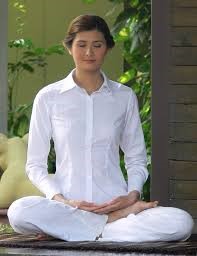
The main vehicle for spreading the teachings is vijjā dhammakāya meditation. [Image at right] It is controversial to some, possibly reflecting tension between its experiential (largely samatha) approach and the more intellectual approach (largely vipassanā) of “cool-structured” official Theravāda (Crosby 2014:155 ff; Scott 2009:80 ff). Cholvijarn (2019), however, maintains that vijjā dhammakāya includes aspects of both samatha and vipassanā. It is based on three methods of concentration (a visualization object, recollection of the Buddha, and mindfulness of breathing), and the “Principle of the Center,” i.e., bringing the focus of these concentrations to the center of the body (Rajyanvisith 2011:26). None of these elements are unique to vijjā dhammakāya, although unifying them into a single system is rare (Newell 2008; Scott 2009).
Details of the method(s) are better addressed by the masters who teach it (e.g., Dhammakaya Foundation 2020; Rajyanvisith 2011). Here we simply note that vijjā dhammakāya is a “relatively simple” visualization technique, which is “easily taught to large groups of people” (Swearer 1991:660). Wat Phra Dhammakāya, because of its mass orientation, has probably taken this further, and other temples in the movement sometimes accuse it of over-simplifying (Cholvijarn 2019; Newell 2008; Scott 2009). It should also be noted that many monks who do not necessarily follow Dhammakāya traditions nevertheless find it useful to learn vijjā dhammakāya (usually from the Wat Paknam or Wat Luang Phor Sodh Dhammakayaram currents), although not exclusively.
Merit-making is also a fundamental element in much Buddhist practice, prominent in both traditional and modern forms of Thai Theravāda. Generosity and giving are one major source of merit, and can bring good karmic results, because they reduce attachment. Strictly speaking, only giving without expectation of return benefits would bring positive karma; if one expects to gain benefits, it may be an expression of greed rather than generosity (e.g., Harvey 2013). There has always been some ambiguity in Thai popular Buddhism about whether merit-making has eventual enlightenment as a goal, or simply fortuitous rebirth, a problem which modern consumerism has exacerbated (Kitiarsa 2007).
Wat Phra Dhammakāya has organized merit-making on a mass commercial scale, with such things as shuttle busses for an easy commute, on site sales of devotional objects, direct selling techniques, and easy credit-card donation payments. “These new religious groups include Dhammakaya which teaches one can buy merit points and reserve a space in heaven by donating to the temple” (Ekachai 2016a). “Merit-making has become a well-packaged and ready-made good which can be easily acquired and ‘consumed’” (Fuengfusakul 1993:168).
Despite such criticisms, Wat Phra Dhammakāya was able to sidestep much serious official opposition for a long time. “Thammakaay has taken pains to present itself as a dynamic, ‘cutting-edge’, reformist movement which respects and accepts the existing order and rules of the game” (Fuengfusakul 1993:176). “The authorities have shown themselves willing to tolerate Thammakaay’s commercial innovations and activities as long as it does not challenge the Sangha Order and the law” (Fuengfusakul 1993:178). This did not change until the past few years when the advantage in Thailand’s color-coded political divide tilted strongly against the side Wat Phra Dhammakāya supported.
ORGANIZATION/LEADERSHIP
Wat Phra Dhammakāya has been quite skilled at marketing itself (Scott 2009), which facilitated becoming more of a mass movement than other versions of reform Buddhism or even other currents of the Dhammakāya movement. Equally important, however, has been its political skill within the traditional official saṅgha hierarchy. Hot-structured Dhammakāya as a movement does not really have any formal leadership, and, indeed, the three main currents are fairly autonomous. But they all recognize and work within the official saṅgha hierarchy, and thus, share most of same organizational structure as official cool-structured Thai Theravāda. In practice, though, Wat Phra Dhammakāya has been most aggressive at building its position and, correspondingly, has been very careful to present itself as subordinate to the official Theravāda saṅgha. (There has rarely been much question about this for the other two main temples, which have usually kept a somewhat lower profile.)
The official saṅgha hierarchy is more-or-less a top-down feudalistic structure. (Ekachai’s 2013 headline says this explicitly: “Sangha feudal hierarchy has to go for good”.) The top position (Saṅgharāja) is based almost entirely on seniority, although with some concession to alternating between the two official orders of monks. Wat Prah Dhammakāya and Wat Paknam (which are Mahanikaya) have many very senior monks (e.g., McCargo 2012), partly because they stress lifetime ordination more strongly than many other temples. A Wat Paknam monk was appointed acting Saṅgharāja upon the death of the serving head in 2013, but was never confirmed permanently. He was a Wat Prah Dhammakāya ally, and after the 2014 coup, the government declined to forward his nomination to the King for approval. After several years of political maneuvering, a technical change in the law gave the King the choice, rather than just approval power. A new Saṅgharāja was appointed in 2017, bypassing both strict seniority and much meaningful participation by the saṅgha hierarchy that would have benefitted Dhammakāya monks (Kulabkaew 2019; Malikhao 2017).
Within Wat Prah Dhammakāya itself, Phra Dhammachayo was the undisputed head until recently. This top down administrative structure is how most temples are run, so the formal structure is not unusual, but the substance of it was. Laohavanich (2012) describes Phra Dhammachayo’s authority as quite cult-like, and any opposition or criticism could result in expulsion from the temple. (Expelled monks usually moved to one of the other Dhammakāya movement temples.) His formal authority declined somewhat when he stepped down in 2011 (not entirely clear why, possibly for health reasons), but Phra Dattacheevo always worked closely with him anyway. In 2016-2017, the government aggressively pursued new corruption charges, attempted to arrest him, and Phra Dhammachayo disappeared to avoid prosecution. He is rumored to have left the country. The government somewhat halfheartedly continues to look for him (Bangkok Post 2019), but seems fairly content to leave it at simply a top management purge of Wat Prah Dhammakāya.
ISSUES/CHALLENGES
The Dhammakāya movement as a whole is likely to remain strong, but the fortunes of Wat Phra Dhammakāya specifically have declined somewhat in the past few years. Wat Phra Dhammakāya aligned with the pro-Thaksin reds in Thailand’s color-coded political wars of the past two decades (McCargo 2012; Prateepchaikul 2015b; Malikhao 2017). When Thaksin’s factions held power, this alignment gained the temple some advantage, including favorable resolution of serious corruption charges, which were dropped in 2006 (e.g., Prateepchaikul 2015a; Malikhao 2017). The alignment cost some middle class support, and the current factions which came to power in the 2014 coup are again pursuing corruption charges against its leaders (e.g., Malikhao 2017; but also against other corrupt clergy, e.g., Ekachai 2018).
The earlier corruption scandal concerned embezzlement charges over Phra Dhammachayo’s insistence that roughly Baht 900,000,000 (≈ US$ 30,000,000) in donations, mostly land, had been to him personally, rather than to the temple. The Saṅgharaja at the time actually recommended that he be defrocked, although partly because the issue became entangled with the true-Self / nibbāna doctrinal debate. Dhammakāya allies in the Supreme Saṅgha Council prevented his defrocking, and political allies got the charges dropped in 2006 on the grounds that he had recently returned the land to the temple (Prateepchaikul 2015a; Scott 2009; Swearer 2010). The current scandal regards charges of using donations to launder nearly 1,000,000,000 of the Baht 12,000,000,000 (≈ US$ 400,000,000) embezzled from Klongchan Credit Union (Bangkok Post 2019; Kulabkaew 2019; Prateepchaikul 2015a).
Most of the middle class has been happy to see efforts to purify the saṅgha, including Wat Phra Dhammakāya, of corruption, but is less enthusiastic about “purifying” Theravāda of unorthodox views. They are somewhat at odds with both factions described in Kulabkaew (2019), which simplifies things into a struggle between religious conservatives who believe more lay (and government) control can uphold orthodox Theravāda, vs. the saṅgha hierarchy, allied with Wat Phra Dhammakāya (and, for a while, Thaksin’s political parties) to protect their own positions. Many are glad Wat Phra Dhammakāya’s influence has been curbed, but the issue is accountability, not doctrine, and they do not want to see it banned.
The real problem is not the temple and its beliefs, but rather, the weakened condition of Buddhism in Thailand. Several articles by Sanitsuda Ekachai, the Bangkok Post columnist, articulate these middle-class views well.
“let me be clear. I don’t like Dhammakaya. I don’t like it cashing in on people’s superstitions and faith. I don’t like how it spins Buddhist teachings, how it quantifies merit in monetary terms, how it caters to the rich, how it buys influence in the clergy and officialdom, how the temple is entangled in a web of corruption such as the Klongchan Credit Union scandal which led to Phra Dhammajayo’s legal charges, and how the ex-abbot is using his supporters to protect himself which may cause violence” (Ekachai 2017).
Nevertheless,
[Wat Phra Dhammakāya’s] promise of heaven in return for donations is rooted in traditional belief. Its rise to prominence stems from theclergy’s failure to speak to the middle class and respond to their needs. Meanwhile, its successful infiltration of the council derives from the elders’ and the system’s own weaknesses (Ekachai 2015).
By kowtowing to elders, Dhammakaya connections and influence have dominated the clergy’s top echelon. For criticising the Sangha Council, Santi Asoke was banished (Ekachai 2016a).
Santi Asoke (Heikkilä-Horn 2016), of course, is another version of modern middle class Buddhist reform in Thailand, cool-unstructured in Rawlinson’s (2000) framework (Speece 2013, 2019). (Thai know that Ekachai’s term “banished” means that their monks were expelled from the official saṅgha and cannot legally call themselves Theravāda. They were not “banned” as sometimes appears in Western accounts, but are free to practice as long as they do not represent themselves as Theravāda.)
No, Dhammayaka is not dangerous. It is just one of new religious groups that has emerged with new needs in our modern consumerist society. What is dangerous to Thai Buddhism is the corruption-ridden clergy autocracy (Ekachai 2018).
The Dhammakāya movement does not seem to be seriously damaged by current political trends. Wat Phra Dhammakāya is somewhat chastened, but that may be to its long-term advantage. Early on, Ekachai already recognized its strong appeal:
Urban Thai society is ruled by consumer culture, and the [Wat Phra] Dhammakaya movement by integrating capitalism into its structure has become popular with contemporary urban Thais who equate efficiency, orderliness, cleanliness, elegance, grandeur, spectacle, competition, and material success with goodness (Ekachai 1998).
The things that attract a major segment of the middle class remain. Much of what they condemned was never as strong in the other Dhammakāya temples. It has been tamed in Wat Phra Dhammakāya, and the charismatic leadership that promoted such excesses is not likely to regain power. Long term, the Dhammakāya movement is likely to remain prominent in Thailand’s growing Buddhist diversity.
IMAGES
Image #1: Phra Mongkol Thepmuni.
Image #2: Wat Paknam.
Image #3: Khun Yay Maharatana Upasika Chandra Khonnokyoong.
Image #4: Wat Phra Dhammakāya.
Image #5: Phra Thepyan Mongkhon.
Image #6: King Mongkut.
Image #7: Wat Phra Phra Dhammachayo.
Image #8: Vijjā dhammakāya meditation.
REFERENCES
Buddhadāsa, Bhikkhu. 2016. Nibbāna For Everyone (translated by Santikaro). Norwalk, WI: Liberation Park.
Buranajaroenkij, D., P. Doneys, K. Kusakabe, and D. L. Doane. 2018. “Expansion of Women’s Political Participation through Social Movements: The Case of the Red and Yellow Shirts in Thailand.” Journal of Asian and African Studies 53:34-48.
Cantwell, Cathy, and Hiroko Kawanami. 2002. Buddhism. Pp. 47-81 in Religions in the Modern World: Traditions and Transformations, edited by Linda Woodhead, Paul Fletcher, Hiroko Kawanami, and David Smith. London: Routledge.
Cholvijarn, Potprecha. 2011. Nibbāna as True Reality beyond the Debate: Some Contemporary Thai Discussions. Rajburi, Thailand: Wat Luang Phor Sodh Dhammakayaram.
Cholvijarn, Potprecha. 2019. The Origins and Development of Sammā Arahaṃ Meditation: From Phra Mongkhon Thepmuni (Sot Candasaro) to Phra Thep Yan Mongkhon (Sermchai Jayamaṅgalo). PhD dissertation, University of Bristol, U.K.
Cohen, Paul T. 2001. “Buddhism Unshackled: The Yuan ‘Holy Man’ Tradition and the Nation-State in the Tai World.” Journal of Southeast Asian Studies 32:227-47.
Cousins, L. S. 1997. Aspects of esoteric southern Buddhism. Pp. 185-207 in Indian Insights: Buddhism, Brahmanism and Bhakti, edited by Peter Connolly and Sue Hamilton). London: Luzac Oriental.
Crosby, Kate. 2000. “Tantric Theravāda: A Bibliographic Essay on the Writings of François Bizot and others on the Yogāvacara Tradition. Contemporary Buddhism 1:141-98.
Crosby, Kate. 2014. Theravada Buddhism: Continuity, Diversity, and Identity. Oxford, U.K: Wiley.
Dhammakaya Foundation. 2020. “Teachings.” Accessed from https://en.dhammakaya.net/teachings/#meditation on 10 August 2020.
Dhammakaya Foundation. 2010a. The Life and Times of Luang Phaw Wat Paknam (Fourth Edition). Pathum Thani, Thailand: Dhammakaya Foundation. Accessed from https://en.calameo.com/read/00280806695da2cf703d4 on 10 August 2020.
Dhammakaya Foundation. 2010b. Second to None: The Biography of Khun Yay Maharatana Upasika Chandra Khon-nok-yoong, Second revised edition. Dhammakaya Foundation, Bangkok. Accessed from https://web.archive.org/web/20160819002003/http://en.dhammakayapost.org/download/book/04-Second-to-None.pdf on 10 August 2020.
“DSI to renew efforts to collar fugitive rogue monk.” 2019. Bangkok Post, July 29. Accessed from https://www.bangkokpost.com/thailand/general/1720959/dsi-to-renew-efforts-to-collar-fugitive-rogue-monk on 10 August 2020.
Ekachai, Sanitsuda. 2018. “Buddha’s Path Must Guide Reform of Clergy.” Bangkok Post, June 7. Accessed from https://www.bangkokpost.com/opinion/opinion/1480325/buddhas-path-must-guide-reform-of-clergy on 10 August 2020.
Ekachai, Sanitsuda. 2017. “Making Thai Buddhism relevant again.” Bangkok Post, March 1. Accessed from https://www.bangkokpost.com/opinion/opinion/1206865/making-thai-buddhism-relevant-again on 10 August 2020.
Ekachi, Sanitsuda. 2016a. “Clergy must drop its dependence on state.” Bangkok Post, February 24. Accessed from https://www.bangkokpost.com/opinion/opinion/874388/clergy-must-drop-its-dependence-on-state on 10 August 2020.
Ekachai, Sanitsuda. 2016b. “Grim future for bhikkhuni under CDC draft.” Bangkok Post, April 20. Accessed from https://www.bangkokpost.com/opinion/opinion/939937/grim-future-for-bhikkhuni-under-cdc-draft on 10 August 2020.
Ekachai, Sanitsuda. 2015. “Dhammakaya is only a symptom.” Bangkok Post, February 25. Accessed from https://www.bangkokpost.com/opinion/opinion/483196/dhammakaya-is-only-a-symptom on 10 August 2020.
Ekachai, Sanitsuda. 2013. “Sangha feudal hierarchy has to go for good.” Bangkok Post, October 30. Accessed from https://www.bangkokpost.com/opinion/opinion/377066/sangha-feudal-hierarchy-has-to-go-for-good on 10 August 2020.
Ekachai, Sanitsuda. 1998. “Phra Dhammakaya Temple Controversy: Keeping the Faith.” Bangkok Post, December 21. Accessed from https://culteducation.com/group/1289-general-information/8544-phra-dhammakaya-temple-controversy.html on 10 August 2020.
Foxeus, Niklas. 2016. “’I am the Buddha, the Buddha is me:’ Concentration meditation and esoteric modern Buddhism in Burma/Myanmar.” Numen 63:411-45.
Foxeus, Niklas. 2013. “Esoteric Theravada Buddhism in Burma/Myanmar.” Scripta Instituti Donneriani Aboensis [S.l.]. Digital Religion 25:55-79.
Fuengfusakul, Apinya. 1993. “Empire of crystal and utopian commune: two types of contemporary Theravada reform in Thailand.” Sojourn 8:153-83.
Harvey, Peter. 2013. An Introduction to Buddhism: Teachings, History and Practices, Second Edition. Cambridge, U.K: Cambridge University Press.
Heikkilä-Horn, Marja-Leena. 2016. “Santi Asoke. World Religions and Spirituality Project.” Accessed from https://wrldrels.org/2016/10/08/santi-asoke-2/ on 10 August 2020.
Jackson, Peter A. 2003. Buddhadāsa: Theravada Buddhism and Modernist Reform in Thailand. Chiang Mai, Thailand: Silkworm Books.
Keyes, Charles F. 1992. “Buddhist politics and their revolutionary origins in Thailand.” Pp. pp. 319-50 in Innovation in Religious Traditions, edited by Michael A. Williams, Collett Cox, and Martin S. Jaffee. Berlin: de Gruyter.
Kitiarsa, Pattana. 2007. “Thailand’s prosperity religion and its commodifying tactics.” Pp. 120-43 in Religious Commodifications in Asia: Marketing Gods, edited by Pattana Kitiarsa. London: Taylor & Francis.
Kulabkaew, Katewadee. 2019. The Politics of Thai Buddhism under the NCPO Junta. Trends in Southeast Asia Series, No. 8. Singapore: ISEAS – Yusof Ishak Institute.
Laohavanich, Mano Mettanando. 2012. “Esoteric Teaching of Wat Phra Dhammakāya.” Journal of Buddhist Ethics 19:483- 513.
Mackenzie, Rory. 2007. New Buddhist Movements in Thailand: Towards an Understanding of Wat Phra Dhammakaya and Santi Asoke. New York: Routledge.
Magness, T. n.d. The Life and Teaching of The Ven. Chao Khun Mongkol-Thepmuni. Accessed from https://www.meditation101.org/attachments/view/?attach_id=23963 on 10 August 2020.
Malikhao, Patchanee. 2017. ”Analyzing the ‘Dhammakaya Case’ Online.” Pp. 17-35 in Culture and Communication in Thailan, edited by Patchanee Malikhao). Singapore: Springer.
McCargo, Duncan. 2012. “The changing politics of Thailand’s Buddhist order.” Critical Asian Studies 44:627-42.
Newell, Catherine S. 2008. Monks, Meditation and Missing Links: Continuity, “Orthodoxy” and the Vijjā Dhammakāya in Thai Buddhism. PhD dissertation, SOAS, University of London, London.
Payutto, Ven. Prayudh A. 2007. Vision of the Dhamma: A Collection of Buddhist Writings in English. Nakhon Pathom, Thailand: Wat Nyanavesakavan.
Prateepchaikul, Veera. 2015a. “The Sangha’s Shock Ruling Leaves it Ripe for Reform. Bangkok Post, February 23. Accessed from https://www.bangkokpost.com/opinion/opinion/481065/the-sangha-shock-ruling-leaves-it-ripe-for-reform on 10 August 2020.
Prateepchaikul, Veera. 2015b. “Finally, Dhammakaya’s political alliances made clear.” Bangkok Post, February 27. Accessed from https://www.bangkokpost.com/opinion/opinion/485118/weng-tojirakarn-revelation-of-wat-dhammakaya-links-to-the-red-shirts-and-thaksin-mean-a-clear-explanation-is-due-from-the-attorney-general-says-veera-pradeepchaikul on 10 August 2020.
Puntarigvivat, Tavivat. 2013. Thai Buddhist Social History. Bangkok: World Buddhist University.
Rajyanvisith, Phra. 2011. The Heart Of Dhammakāya Meditation. Wat Luang Phor Sodh Dhammakayaram, Fourth Edition. Accessed from http://www.dhammacenter.org/upload/e-book/57ef93feaf6721a24700b2d7fc565191.pdf on 10 August 2020.
Rawlinson, Andrew. 2000. “A Model of Experiential Comparative Religion.” International Journal of Transpersonal Studies 19:99-108.
Reynolds, Frank E. 1977. “The several bodies of Buddha: Reflections on a neglected aspect of Theravada tradition.” History of Religions 16:374–89.
Satha-Anand, Suwanna. 1990. “Religious Movements in Contemporary Thailand: Buddhist Struggles for Modern Relevance.” Asian Survey 30:395-408.
Schlamm, Leon. 2001. “Ken Wilber’s Spectrum Model: Identifying Alternative Soteriological Perspectives.” Religion 31:19-39.
Schober, Juliane. 1995. “The Theravada Buddhist engagement with modernity in Southeast Asia: Whither the social paradigm of the galactic polity?” Journal of Southeast Asian Studies 26:307-25.
Scott, Rachelle M. 2010. “Buddhism, Miraculous Powers, and Gender: Rethinking the Stories of Theravāda Nuns.” Journal of the International Association of Buddhist Studies 33:489-511.
Scott, Rachelle M. 2009. Nirvana for Sale? Buddhism, Wealth, and the Dhammakāya Temple in Contemporary Thailand. Albany: State University of New York Press
Seeger, Martin. 2009a. “The Changing Roles of Thai Buddhist Women: Obscuring Identities and Increasing Charisma.” Religon Compass 3:806–22.
Seeger, Martin. 2009b. “Phra Payutto and Debates ‘On the Very Idea of the Pali Canon’ in Thai Buddhism.” Buddhist Studies Review 26:1-31.
Seeger, M. 2006. “The bhikkhunī-ordination controversy in Thailand.” Journal of the International Association of Buddhist Studies 29:155-83.
Speece, Mark W. 2019. “Sustainable Development and Buddhist Economics in Thailand.” International Journal of Social Economics 46:704-21.
Speece, Mark W. 2013. “Modern urban reform Buddhism in Thailand.” IAPR 2013 Congress, International Association for the Psychology of Religion. 27-30 August 2013, Lausanne, Switzerland. Accessed from https://papers.ssrn.com/sol3/papers.cfm?abstract_id=2535746) on 10 August 2020.
Speece, Mark and Jitnisa Roenjun. 2016. “Psychographics of Religiosity and the Nature of Just Economic Systems: Examining Buddhist Reform Movements in Thailand.” Pp. pp. 533-54 in Proceedings of the 41st Annual Macromarketing Conference, Dublin, July 13-15 2016.
Swearer, Donald K. 2010. The Buddhist World of Southeast Asia, Second Edition. Albany, NY: State University of New York Press.
Swearer, Donald K. 1991. “Fundamentalistic Movements in Theravada Buddhism. Pp. 628-90 in Fundamentalisms Observed, edited by Martin E. Marty and R. Scott Appleby. Chicago: University of Chicago Press.
Tambiah, Stanley J. 1976. World Conqueror and World Renouncer: A Study of Buddhism and Polity in Thailand against Historical Background. Cambridge, U.K.: Cambridge University Press.
Taylor, James. 2008. Buddhist Modernities, Heresy and Hybridization: Thailand’s Thammakaai. Pp. 37-64 in: Buddhism and Postmodern Imaginings in Thailand: The Religiosity of Urban Space, edited by James Taylor. Farnham, U.K.: Ashgate Publishing.
Taylor, James. 1999. “(Post-) Modernity, Remaking Tradition and the Hybridization of Thai Buddhism.” Anthropological Forum 9:163-87.
“Thailand: Sangha needs to look within.” 2008. Bangkok Post, May 16. Accessed from https://www.buddhistchannel.tv/index.php?id=52,6430,0,0,1,0 on 10 August 2020.
Tomalin, E. 2006. “The Thai bhikkhuni movement and women’s empowerment.” Gender & Development 14:385-97.
Visalo, Phra Paisal. 2012. “Thai Buddhism in the Next Decade: As Thai society moves with the times, so do its religious beliefs and practices.” Bangkok Post, July 2. Accessed from http://www.visalo.org/englishArticles/BkkPost_budNextDecade.htm on 10 August 2020.
Wat Paknam. 2016. Commentaries on Buddhist Doctrines & Precepts Volume 1: Ordination of Female Buddhist Monks (Bhikkhuni). Accessed from https://www.meditation101.org/16012522/9-commentaries-on-buddhist-doctrines-precepts-1 on 10 August 2020.
Williams, Paul. 2008. Mahayana Buddhism: The Doctrinal Foundations, Second Edition. London: Routledge.
Zehner, Edwin. 1990. “Reform Symbolism of a Thai Middle-Class Sect: The Growth and Appeal of the Thammakai Movement.” Journal of Southeast Asian Studies 21:402-26.
Publication Date:
29 September 2020
